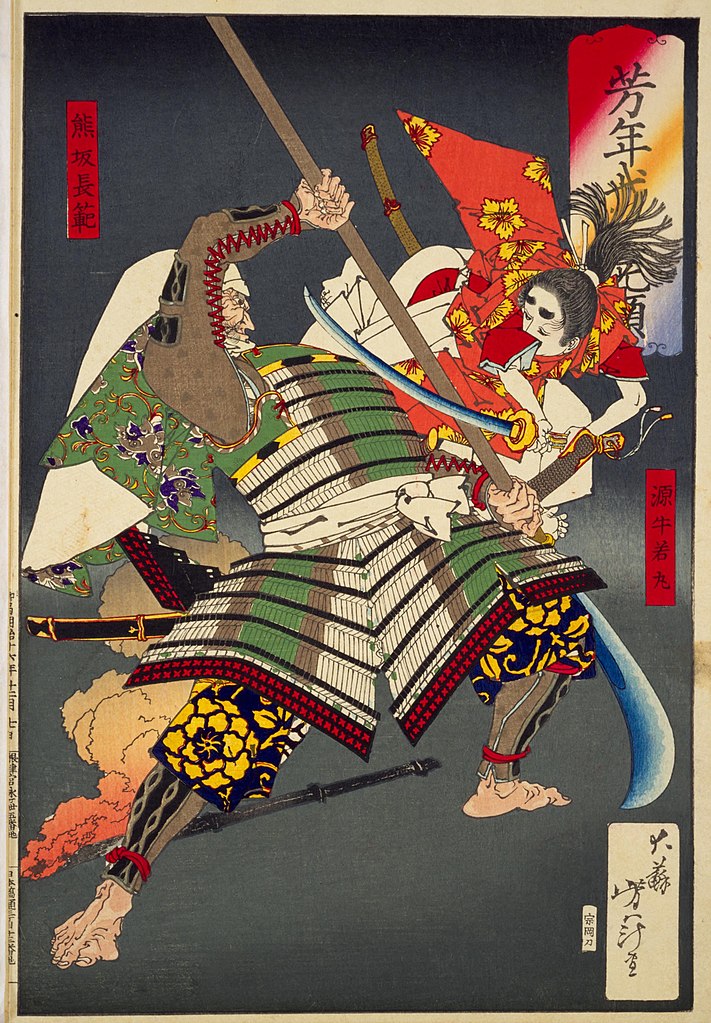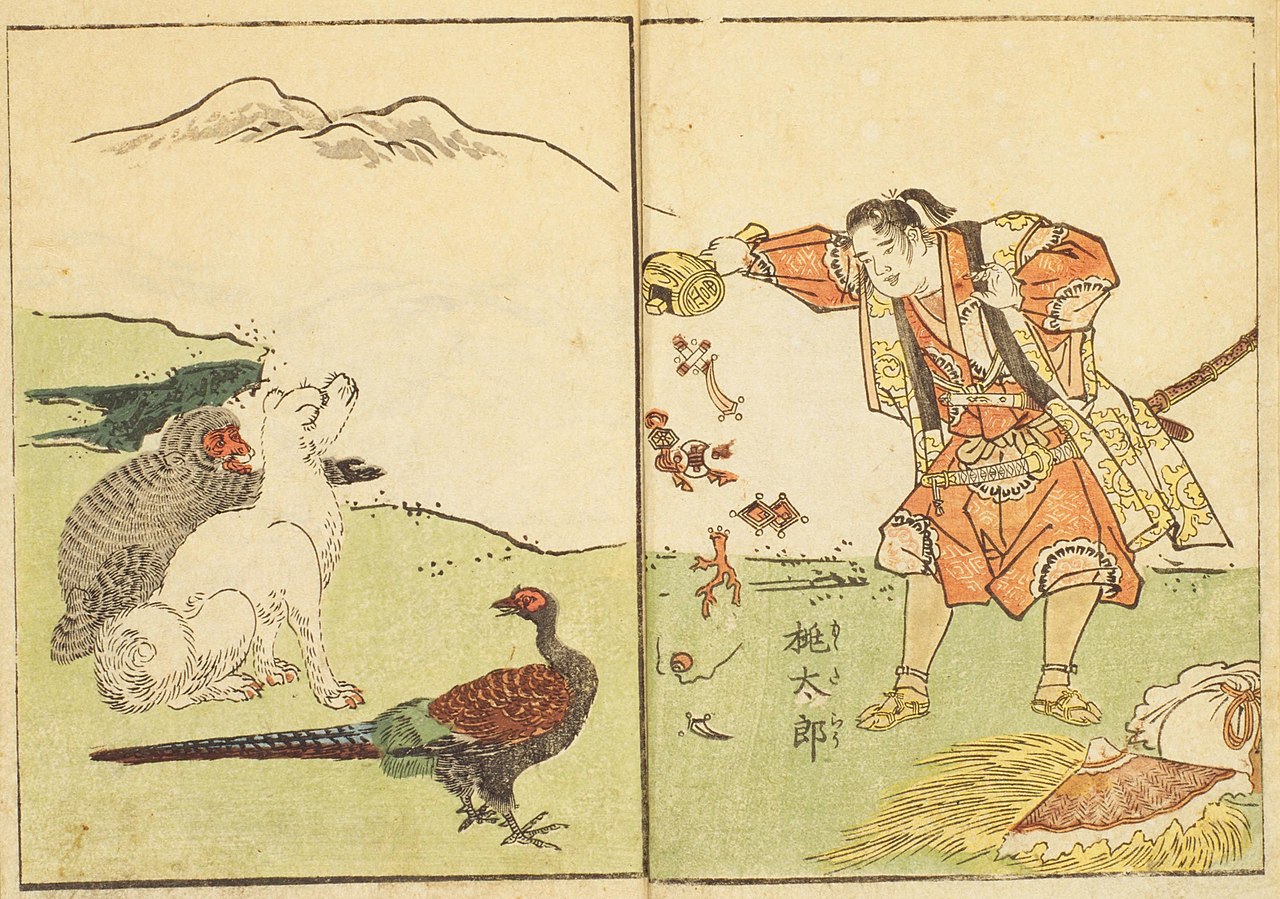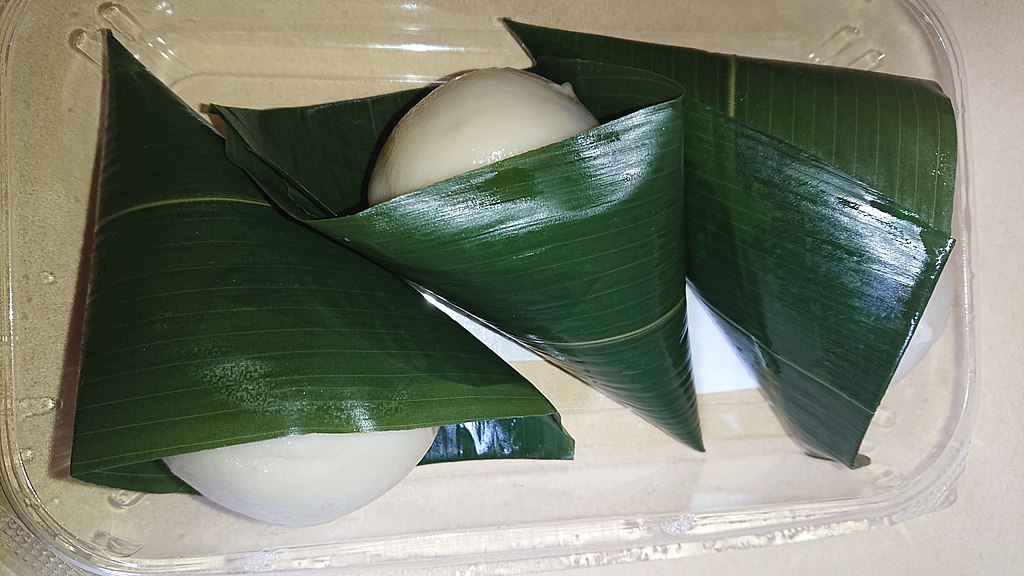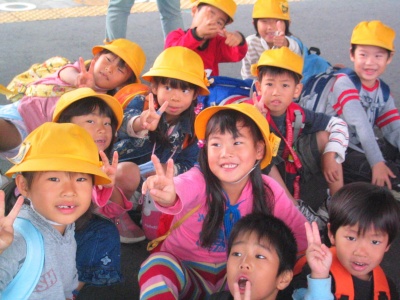Japanese kids: heroes, foods, games, and naming traditions

Across the planet there are ancient and not-so old stories of heroes that inspire children. Today, Marvel Comics provides lots of heroes. But that is so new compared to the old stories we have from Japan.
The big old kids' heroes of Japan are primarily "fortune children" who share unusual births, supernatural powers, and the ability to bring wealth and overcome evil. And their semi-sacred status, gave children important roles in Shinto rituals because they symbolize pure spirit overcoming brute force. The big heroes of Japan for children include Momotaro (Peach Boy), Issunboshi (Japan's Tom Thumb), Golden Boy (Kintaro), and Ushiwaka-maru (a Genji aristocrat trained by tengu mountain goblins in the martial arts).
And then there are all the snacks and desserts created for Japanese children, who, as you may know, are celebrated in March (Doll's Day; for girls, natch) and in May (Boy's Day; flying carp streamers). Many kids' foods are connected to these two months but can be found year-round across Japan if you know what you are looking for. And if you are traveling in Japan with your children, you should know what to look for in the way of healthy, fun traditional kids' foods for your children.
Today, Japanese children are more likely to be playing games on devices. It's true! But the old world games are still around and they are fun, simple and can be taken home. Old Japanese games rely on Japan's amazing craft skills, especially wood crafts. For example, the takeuma stilts that make kids taller than their parents are made from bamboo. The Japanese also have lots of singing games and simple card games that kids continue to enjoy if taught.
The naming of children is an obscure art the world over, and bad luck stemming from the wrong name is well known in many cultures. Superstitious beliefs run deep in Japan and onomancers (diviners or oracles) were consulted frequently when kids were born in old Japan. For example, the kanji or Chinese ideograms chosen might result in bad luck if the stroke count was unlucky. One guiding principle for naming kids in Japan was using names ending with exemplary character traits like correct or morally upright. Other names were like Western names: lovely or bright for girls; esteemed or noble for boys.
Content by Ian Martin Ropke, owner of Your Japan Private Tours (est. 1990). I have been planning, designing, and making custom Japan private tours on all five Japanese islands since the early 1990s. I work closely with Japan private tour clients and have worked for all kinds of families, companies, and individuals since 1990. Clients find me mostly via organic search, and I advertise my custom Japan private tours & travel services on www.japan-guide.com, which has the best all-Japan English content & maps in Japan! If you are going to Japan and you understand the advantages of private travel, consider my services for your next trip. And thank you for reading my content. I, Ian Martin Ropke (unique on Google Search), am also a serious nonfiction and fiction writer, a startup founder (NexussPlus.com), and a spiritual wood sculptor. Learn more!
Japan’s Old Child Heroes: Momotaro, Issunboshi, Kintaro and Yoshitsune

If anyone needs a hero, then it is the children of the world! How else would we be able to fight our way through the twists and turns of early life to adulthood? Japan’s child heroes of the past give every child what they need and what they want. Here are four young heroes that are alive and well today.
Japanese fairy tales feature many "fortune children" who share unusual births, supernatural powers, and the ability to bring wealth and overcome evil. These child heroes were sometimes thought to be incarnated benevolent deities. Due to this marginal semi-sacred status, children played important roles in Shinto ritual: they symbolize pure spirit overcoming brute force.
Probably the most well-known "fortune" child is the Peach Boy, Momotaro, who got his name by popping out of a huge peach (momo) found floating down a river. He soon grows into a strapping lad determined to subdue a rampaging band of oni—ugly, stupid, dangerous mountain demons. On the way he is joined by a dog, a monkey, and a pheasant. Despite the odds, the plucky foursome soon bring the demons to their knees and return home loaded with treasure.
Japan's Tom Thumb, Issunboshi (One Inch Boy), boldly sails up the Yodogawa River (Osaka) in a soup bowl to seek his fortune in Kyoto. He so impresses a government official with his spunk that the man makes Issunboshi his daughter's bodyguard. On the way home from Kiyomizu Temple one day, a ferocious oni attempts to abduct the girl. Issunboshi tires to save her but gets swallowed in the process. No problem: drawing his needle sword, he kills the monster from within. Then with the demon's magic mallet, the grateful girl increases Issunboshi's height to a more marriageable degree.
The Golden Boy, Kintaro, is often shown in his red apron either lifting heavy objects aloft or wrestling. Ruddy-cheeked and pudgy, by the time he could crawl his strength was superhuman, and as a boy he ran wild in the mountains uprooting trees and wrestling with his animal friends. Only the squirrel could beat him, and that was by tickling him. He is said to have become one of the four followers of the oni-killer, Ushiwaka-maru, famous for rescuing Kyoto maidens from the giant Mount Oe demon, Shuten-doji.
Ushiwaka-maru (the childhood name of the great Yoshitsune of the great Genji clan) is said to have been trained by a powerful tengu (winged, red-faced, long-nosed mountain goblins) in the heavily wooded mountains of Kyoto’s Kurama to become a strong warrior and military strategist. His first big battle was with with Benkei at Gojo Bridge (see photo). Benkei, an eight-foot-tall warrior-monk from Mt. Hiei's Enrakuji Temple, boasted he would take the swords of one thousand opponents. He had already collected 999, when one evening, he encountered a slender Ushiwaka-maru playing a flute on the moonlit Gojo Bridge. When Benkei demanded the youth identify himself, the boy ignored him, and Benkei prepared to get his thousandth sword. But thanks to the tengu's lessons, Ushiwaka-maru easily remained just out of the monk's reach until the exhausted Benkei surrendered and pledged his eternal loyalty. The two eventually went on to destroy the Taira clan in the epic 1185 battle of Dan-no-ura.
Foods that kids loved in the 1920s and today!

The Boy's Day festival of May brings with it two traditional sweets welcomed by child and adult alike. Chimaki are elongated pieces of mochi (pounded sticky rice) wrapped and steamed in the aromatic leaves of the dwarf bamboo. They usually come tied together in bundles of five. Then there's kashiwa-mochi, another variation on mochi, this time wrapped in a kind of oak leaf. It comes filled with either bean paste or, my absolute favorite, sweet miso. On May 5th these sweets are usually set on a little stand which is placed in front of the family's set of toy samurai armor.
"Scattered" sushi (called chirashi-zushi when ordered from a sushi shop or if home made) is a huge favorite with kids year-round. Think of a bed of vinegar-flavored sushi rice decorated with shrimp, sashimi fish, green peas, and then sprinkled with slivers of omelette. Perfect for picnics or a quick snack.
In Kyoto, there is a super famous shop that specializes in things for children from “old world” Japan. Everything from hero masks and games to an incredible range of snacks and candies. And that shop is called Funahashiya. And it is also famous for kites, decorated with dragons, carp, and various heroes, usually samurai. Tradition demands that when a son is born, his name be written on the back of a kite which the father then flies--just another excuse to be a kid! Of course, Funahashiya's owner, Mr. Tsuji, is still a child at heart. He not only sells kites but makes his own and on occasion teaches kite-making. He has several books for sale on the subject in the back of the store.
Many of the sweets Funahashiya sells are traditional, old-fashioned ones. Apparently, the shop has 1,000 kinds of toys and sweets, and about 300 different masks. And don’t forget to try their nikkisui, cinnamon-flavored colored water.
Before the days of sugar, a product called mizu-ame was the standard. It's made from rice and is very sticky and moderately sweet. Hard candies are made from this, and some of these lollipop-like things are then coated with toasted soybean powder. Called kinako-ame, they are quite tasty. Another tasty tooth-puller (no kidding!) is called imo-ame. It should be sucked. It looks like a potato.
Katayaki means hard-baked and refers to a kind of traditional crackers. They are so hard it takes forever to eat, which is probably why mothers gave them to the kids. The main use, though, was as travel food for monks and ninja, as they never go bad.
Funahashiya candy & toy shop, Kyoto: On the west side of Teramachi Street, about 100 meters south of Shijo, Kyoto. Open 10:30 - 19:00, sometimes closed on Thursdays.
Japanese children: Still having fun in traditional ways

What do modern children do to have fun? In what seems to be a world-wide phenomenon the answer has become increasingly the same: they play with devices. But what did they play with before devices existed?
Kyoto has been a central point of focus for Japanese culture since ancient times and is probably the one place all foreign tourists visit. For non-Japanese, when it comes to Japanese culture, many naturally think of things like traditional theatre, art, clothing and fabrics, and gardens. However, what is should never be forgotten is, Japan’s popular, grass-roots culture.
May in general and May 3rd in particular is children’s month in Japan. Here are a few of the old traditional games and past times most Japanese children and, of course adults, are familiar with. These games and amusements are fun, maybe there’s something here that you can teach your children or friends.
Takeuma: Walking around on stilts made of bamboo trees.
Bosan ga he-o koita: One kid, the "oni (devil)," faces a wall and says "Bosan-ga he-o koita, nioi-dara kusakatta (lit. the monk farted, and it smelled bad)." Other kids behind him/her move forward as far as they can, while the phrase is read. The oni turns around when finishing saying it, and others have to stop their motion completely. I f anyone moves even a bit, she/he is "chained" to the oni by inter-twinning their baby fingers. When all the kids have been chained, the first chained one becomes the oni. However, when someone reaches and touches the oni before she/he finishes saying the phrase, all the chained kids are released and start running. After counting a few seconds, the oni chases them. The first one caught becomes the new oni.
Hanaichi Monme: The children divide themselves into two groups. The each of the group members of either side decide together who they want from the other group. Then, holding hands, the groups move back and forth singing, "who do you want" followed by " we want so and so." The wanted ones then play janken (stone, scissors and paper) to decide who gets who. The game is over when there is only one big group left.
Kendama: This cup, ball, stick game has been around for centuries. It’s a game for one. Doing various tricks of varying difficulty, each person tries to throw the ball (tied to the stick) in such a way that they catch it in the cup.
With Takeuma, children learn physical balance. Bosan-ga he-o koita teaches children performance skills in that they have to stay still in a strange posture for a period of time. Hanaichi Monme works to promote team spirit, but it has also been said to be rather cruel, as it often leaves the least popular kid to the last. Kendama teaches children learn how to concentrate, without them realizing it.
These days, children don't play these games as often. More and more the word “game” requires the use of eyes and fingers on some kind of screen. In a way, Kyoto-born-and-raised children are especially lucky because they still have unlimited chances to immerse themselves in the traditional, creative world that lives all around them. Growing up in the countryside or next to it is even better!
Naming children in Japan: A historical perspective
In the Tale of Genji, many of the Shining Prince's lovers are poetically named for the flowers and plants they resembled. For modern Japanese, naming a child is still a creative challenge. Luckily, the combinations of Chinese characters, or kanji, allow for an unlimited number of possibilities.
Traditionally, words denoting exemplary character have been the top preference for names. A favorite one is adashii, meaning correct, upright, or legitimate. In names it is pronounced tada, masa or sho.
Many girls' names end with the character ko, meaning child, while the first character might mean beautiful, lovely, or some other attribute parents deem suitable in a woman. Hence, Yoko (ocean child), Akiko (bright child), or Yoshiko (beautiful child).
In a like fashion, boys' names often denote ideal male qualities. Some typical examples are Hiroshi (esteemed), Akira (bright) and Takashi (noble).
Nowadays, parents are just as likely to pick a name for its sound as its meaning and then attach to it whichever character strikes their fancy. Names with a distinct Western sound, such as Eri or Rika, have been the vogue for the last decades.
Superstitions surrounding names has made the profession of the onomancer a profitable business. The onomancer's job is to check that the given name pairs suitably with the family name in terms of total number of strokes (some numbers are unlucky) and meanings. He or she may even advise a change of name if the given one does not have the right feel to it. After marriage, women may consult an onomancer to see if their first name goes well with their new family name.
Return to the Japanese culture essay index.
Content by Ian Martin Ropke, owner of Your Japan Private Tours (est. 1990). I have been planning, designing, and making custom Japan private tours on all five Japanese islands since the early 1990s. I work closely with Japan private tour clients and have worked for all kinds of families, companies, and individuals since 1990. Clients find me mostly via organic search, and I advertise my custom Japan private tours & travel services on www.japan-guide.com, which has the best all-Japan English content & maps in Japan! If you are going to Japan and you understand the advantages of private travel, consider my services for your next trip. And thank you for reading my content. I, Ian Martin Ropke (unique on Google Search), am also a serious nonfiction and fiction writer, a startup founder (NexussPlus.com), and a spiritual wood sculptor. Learn more!